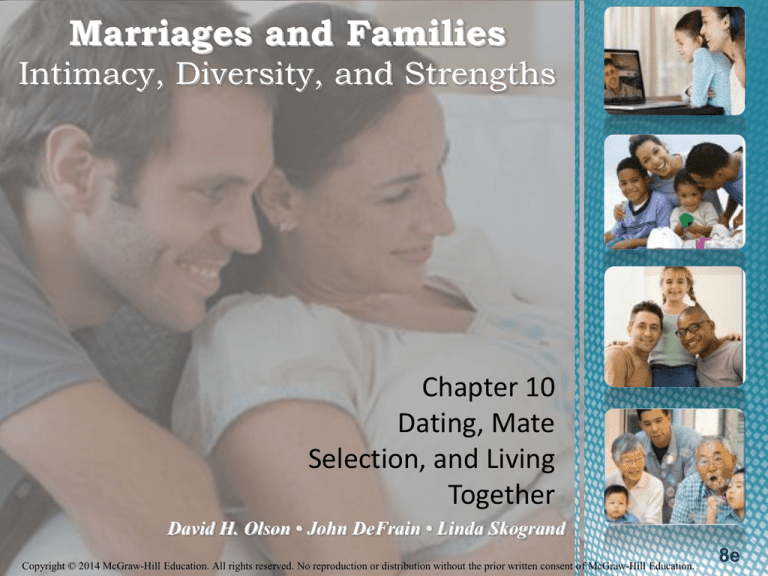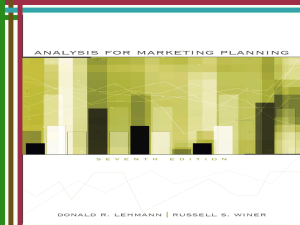
Marriages and Families
Intimacy, Diversity, and Strengths
Chapter 10
Dating, Mate
Selection, and Living
Together
David H. Olson • John DeFrain • Linda Skogrand
Copyright © 2014 McGraw-Hill Education. All rights reserved. No reproduction or distribution without the prior written consent of McGraw-Hill Education.
8e
Courtship patterns
Choosing a mate
Patterns of mate selection
Conflict and violence in dating
Living together
Copyright © 2014 McGraw-Hill Education. All rights reserved. No reproduction or distribution without the prior written consent of McGraw-Hill Education.
10-2
Based on principle that elders have the
wisdom to select the appropriate spouse
Lineage and family status considered more
important than love
Serve to extend existing family units rather
than to create new units
Common in many non-industrialized
cultures
Copyright © 2014 McGraw-Hill Education. All rights reserved. No reproduction or distribution without the prior written consent of McGraw-Hill Education.
10-3
Highly stable
Harmonious
Premarital intimacy is minimal
No risk of being rejected
Do not have to determine whether one’s
partner is committed to the relationship
Copyright © 2014 McGraw-Hill Education. All rights reserved. No reproduction or distribution without the prior written consent of McGraw-Hill Education.
10-4
Freedom of choice in marriage, referred to as
the love match
More likely among people who:
Marry at a later age
Have a higher level of education
Have a higher socioeconomic status
Live in an urban setting
Financially independent women more likely
to opt a love match
Copyright © 2014 McGraw-Hill Education. All rights reserved. No reproduction or distribution without the prior written consent of McGraw-Hill Education.
10-5
Semi-arranged marriages - Parental
approval is obtained before the marriage
Example - India
Love-based marriages - Happens more often
in the larger cities
Example - China
Cohabitation - Most common type of
relationship until after the birth of a child
Example - Sweden
Copyright © 2014 McGraw-Hill Education. All rights reserved. No reproduction or distribution without the prior written consent of McGraw-Hill Education.
10-6
Individual-choice courtship
Permissiveness: Extent to which couples
are physically intimate before marriage
Double standard: Different standards of
sexual and social behavior for men and
women
Copyright © 2014 McGraw-Hill Education. All rights reserved. No reproduction or distribution without the prior written consent of McGraw-Hill Education.
10-7
Source: Excerpt from Joshua Harris, I Kissed Dating Goodbye. Copyright © 2003 by Joshua Harris. Used by permission of Multnomah Publishers, a
division of Random House, Inc.
Copyright © 2014 McGraw-Hill Education. All rights reserved. No reproduction or distribution without the prior written consent of McGraw-Hill Education.
10-8
Hooking up
• Common term with a vague definition, does not
reveal specific details of a relationship
Reasons for confusion in the campus dating
situation
• Little time for dating
• Women’s movement eliminated traditional courtship
rules but did not present alternative conventions
• Coed dorms also contribute to the confusion
• There are countless ways to hang out without the
anxiety and high expectations of a date
Copyright © 2014 McGraw-Hill Education. All rights reserved. No reproduction or distribution without the prior written consent of McGraw-Hill Education.
10-9
Marriage is a major life goal for the majority
Women like to meet a spouse while at college
Relationships are characterized by either too little commitment or too
much
Hooking up
• Distinctive sex-without-commitment interaction ranging from
kissing to oral sex and intercourse
• Ambiguity makes it popular appeal
Dating
carries multiple
from hanging out to a high level of
• Widespread
on mostmeanings
campuses
commitment
Men rarely ask women out and acknowledge being a couple
Being from a divorced or an intact family affects women in marriage
aspirations, getting advice from parents, and hooking up
Copyright © 2014 McGraw-Hill Education. All rights reserved. No reproduction or distribution without the prior written consent of McGraw-Hill Education.
10-10
Dating services - Discreet but expensive
approach
No assurance on the accuracy of information
provided by people
Lacks intimacy
Can be risky
Copyright © 2014 McGraw-Hill Education. All rights reserved. No reproduction or distribution without the prior written consent of McGraw-Hill Education.
10-11
Result of:
• Divorce
• Never been married older people
Offers the potential for happiness and
companionship
May hamper self-confidence
Older people opt for a:
• Direct approach in building relationships
• Long-term companionship instead of living
together or marriage
Copyright © 2014 McGraw-Hill Education. All rights reserved. No reproduction or distribution without the prior written consent of McGraw-Hill Education.
10-12
Physical attractiveness
• Men place a higher premium on physical attraction
Age and finding a mate
• Mating gradient: Women’s tendency to marry men who are better educated or more
successful than they are
• Sex ratio: Relationship between the number of men and number of women of a given
age
Birth order
• No conclusive evidence available to decide if birth order matters in mate section
Similar or different personalities
• Do not impact marital satisfaction
Interracial and interfaith marriages
• Endogamy: Tradition of choosing a mate from within one’s group
• Exogamy: Tradition of choosing a mate from outside one’s group
Copyright © 2014 McGraw-Hill Education. All rights reserved. No reproduction or distribution without the prior written consent of McGraw-Hill Education.
10-13
Is affected by:
Religion and race
Sex and sex roles
Socioeconomic differences
Cultural familiarity
Extended-family agreement
Copyright © 2014 McGraw-Hill Education. All rights reserved. No reproduction or distribution without the prior written consent of McGraw-Hill Education.
10-14
Attachment theory
• Assumes that the same kind of emotional bonds
between parents and children are evident in adult
intimate relationships
Exchange theory
• Focuses on how relationships are developed based on
rewards received between partners
Equity theory
• Focuses on what is fair and unfair in relationships
Copyright © 2014 McGraw-Hill Education. All rights reserved. No reproduction or distribution without the prior written consent of McGraw-Hill Education.
10-15
Life course theories
• Describes how individuals and couples transition
throughout different stages in life
Feminist theory
• Focuses on gender
Socio-biological theory
• Emphasizes how evolutionary factors affect
romantic and sexual preferences
Copyright © 2014 McGraw-Hill Education. All rights reserved. No reproduction or distribution without the prior written consent of McGraw-Hill Education.
10-16
Sources of conflicts
• Early stages of relationship
• Jealousy and other personality issues
• Later stages of relationship
• Differences in background
• Balance of power in the relationship
• Parent relationships
Jealousy and differences in level of
commitment may result in violent behavior
It is likely that violent during dating will continue
after marriage
Copyright © 2014 McGraw-Hill Education. All rights reserved. No reproduction or distribution without the prior written consent of McGraw-Hill Education.
10-17
Two unrelated adults of the opposite sex
sharing the same living quarters before
marriage
Applicable to same-sex unmarried couples
who have an emotional and sexual
relationship
Copyright © 2014 McGraw-Hill Education. All rights reserved. No reproduction or distribution without the prior written consent of McGraw-Hill Education.
10-18
Religion
• More religious individuals are less likely to cohabit
Divorce
• Divorced individuals are more likely to enter into a
cohabiting relationship
Family discord or growing up without father
• Increases the chances of cohabiting
Copyright © 2014 McGraw-Hill Education. All rights reserved. No reproduction or distribution without the prior written consent of McGraw-Hill Education.
10-19
Enables spending more time together
Allows sharing intimacy without the commitment of
marriage
Economic advantage
Allows learning the habits and character of each other
No complicated divorce if the relationship fails
Allows testing compatibility for a potential future marriage
Engagement
Copyright © 2014 McGraw-Hill Education. All rights reserved. No reproduction or distribution without the prior written consent of McGraw-Hill Education.
10-20
Working-class
couples
• Cohabitate more
quickly than middleclass couples
• Better financial
alternative than living
separately
Middle-class
couples
• Have more resources
to live independently
• Work requirements
slowed down move
toward cohabitation
• Seen as a step towards
marriage
Copyright © 2014 McGraw-Hill Education. All rights reserved. No reproduction or distribution without the prior written consent of McGraw-Hill Education.
10-21





